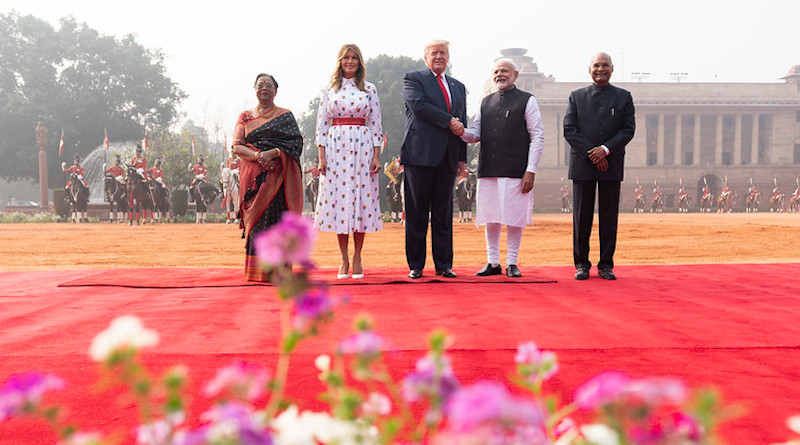The Resilience Of India-US Relations – Analysis
By Observer Research Foundation
Differences remain, but the gains on the positives and negatives of the ledger can be built upon.
By Dhruva Jaishankar
As Donald Trump left India after his maiden visit as United States (US) president, what are we to make of the two-day spectacle? His trip was only the eighth by a serving US president, but he was also the fourth consecutive president to visit. The increased frequency of presidential travel to India captures the growing importance of the country for the US, and highlights the continued investments in the bilateral relationship by successive leaders: Atal Bihari Vajpayee, Manmohan Singh, and Narendra Modi in India; Bill Clinton, George W Bush, Barack Obama, and Donald Trump in the US.
The Trump visit differed from previous ones in several ways, most notably in featuring a major stadium event in Gujarat on Monday. The fact that Trump stayed on script while speaking to an audience of over one lakh, much as he had at the “Howdy Modi” event in Houston last year, was a further departure from the controversy that often accompanies the US president in his international engagements. He struck many of the right notes with his hosts: “America loves India — America respects India — and Americans will always be true and loyal friends to the Indian people,” he said. Trump drew contrasts with another large Asian country: “There’s all the difference in the world between a country that seeks to claim power through coercion, intimidation, aggression and a country that seeks to grow by setting its people free and unleashing their dreams, and that’s India.” Although he mentioned that his administration was “working with Pakistan to crack down on the terrorist organisations and militants that operate on the Pakistani border,” he also expressed hope for “reduced tensions” and “greater stability” in South Asia.
The symbolism, ceremony, rapport between leaders, and political significance naturally received the most attention. Trump arrived in India in an election year, keen to project images of himself addressing large and supportive crowds overseas. He hoped also to appeal to Indian-Americans, who have traditionally supported the Democratic Party. In India too, the visit assumed a political significance, given that public opinion surveys consistently reflect positive Indian attitudes to the US.
But this was also an opportunity to consolidate what is now a substantively richer relationship. The India-US security partnership witnessed another arms purchase, bringing to seven the number of US military platforms that will feature in India’s arsenal, many with components manufactured or assembled in India. Additionally, the signing of three significant defence cooperation agreements; upgraded bilateral, trilateral, and quadrilateral dialogues; and regularised military exercises involving all three services have solidified the defence relationship over the past few years. Coordination on connectivity infrastructure, maritime security, counterterrorism, and cyber security have all increased. Multilateral cooperation, notably at the United Nations Security Council, has improved, as demonstrated after last year’s terrorist attack at Pulwama.
On the economic side, two-way trade in goods and services has increased; India is now the US’ eighth-largest trade partner and the US is India’s largest. Energy trade, in particular, has taken off. The number of Indian students in the US and the number of US companies active in India have both grown. For most US-based tech giants, India is now one of their top three customer bases. Indian companies are investing heavily in the US, as Indian CEOs highlighted to Trump. Meanwhile, Indians have established the largest number of billion-dollar start-up companies in the US founded by immigrants.
Differences remain, as between any two countries. But attempts have been made over the past year to reach accommodations. Worries over possible US sanctions against India related to the purchase of Russian defence equipment have diminished following complications arising from Turkey’s acquisition of similar equipment. The consequences of heightened US tensions with Iran have been managed, with India given time and space to diversify its energy supplies while receiving a waiver from US sanctions for the port project in Chabahar. Many major trade differences have been bridged, including on agriculture and health care, although new points of friction have arisen related to digital payments, data localisation, and e-commerce. On Afghanistan, India has been supportive of efforts to improve coordination between the Trump administration and the government in Kabul as both negotiate with the Taliban. With respect to Pakistan, which has experienced a decline in US military assistance, developments at the Financial Action Task Force suggest new alignments.
Whether or not Trump pulls off a re-election in November, these combined gains on both the positive and negative sides of the ledger are what India and the US can build upon or consolidate. A priority moving forward will involve finalising a trade agreement that brings an end to the application of further tariffs and open-ended commercial disputes. Breakthroughs in defence research and development and resolving immigration irritants will also remain high on the agenda, as will addressing differences over Russia and improving the regulatory environment for US businesses in India. The India-US relationship has proved resilient amid the immense changes underway in international politics. The greatest significance of Donald Trump’s visit as president is the indication that this broad trajectory is likely to continue, even under circumstances that would once have been considered highly unlikely.
This article originally appeared in Hindustan Times.

